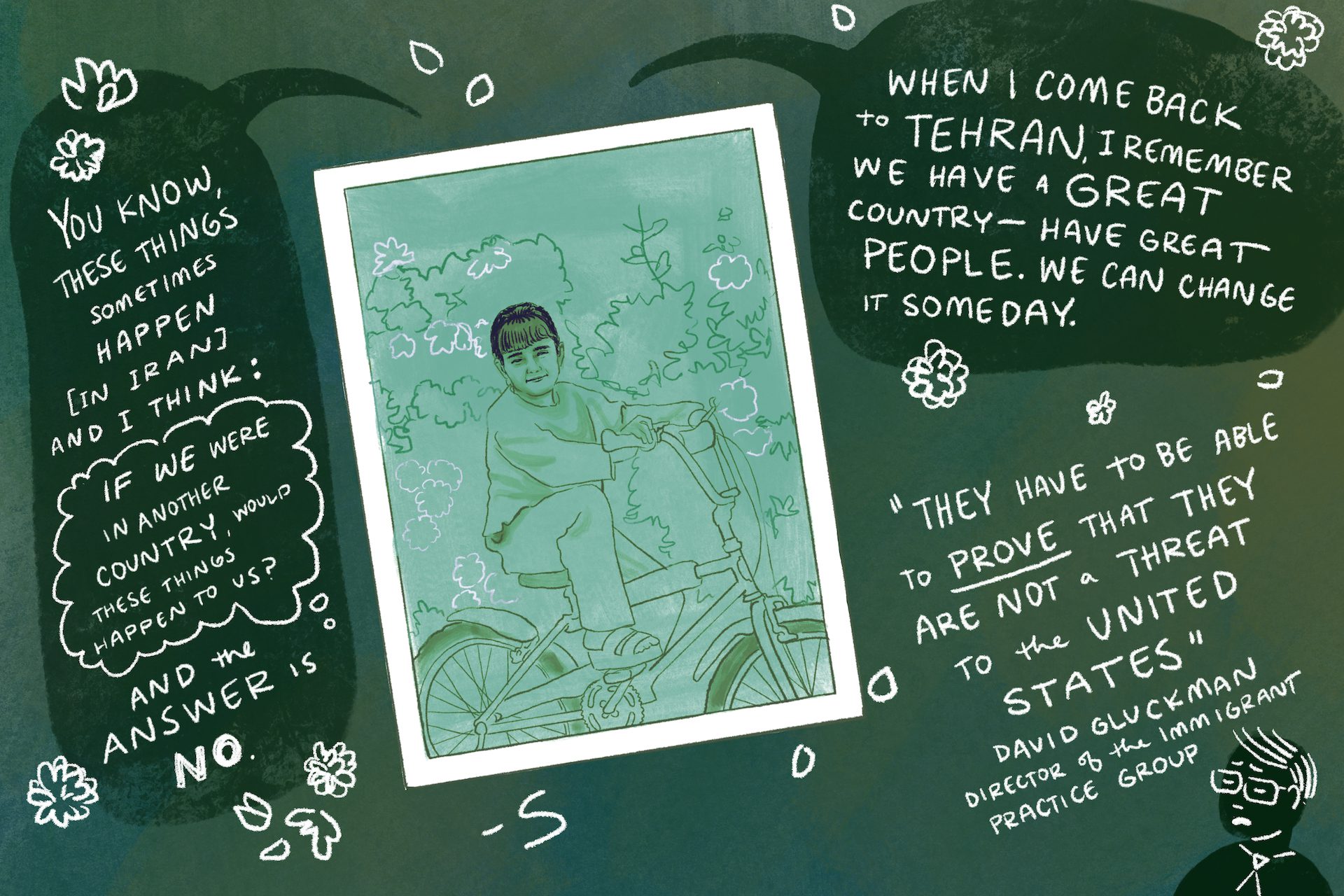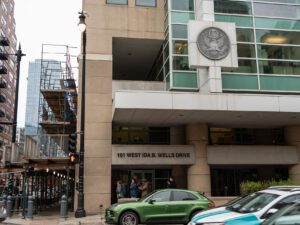 Cori Lin para Borderless Magazine
Cori Lin para Borderless MagazineMuchos estudiantes se enfrentan a la cancelación de citas para entrevistas de visado, esperas de meses y rechazos inexplicables, lo que pone en peligro su asistencia a las universidades estadounidenses.
Tras volar de Teherán a la embajada estadounidense en Armenia, S., que pidió permanecer en el anonimato para no interrumpir su actual solicitud de visado, se quedó helada al encontrarse con la mirada del funcionario de inmigración y oír: "Lo siento, su solicitud de visado ha sido denegada."
Seguramente, escuchó mal.
Pasé ocho meses preparándome para este momento. Había presentado montones de papeles, hecho los exámenes necesarios para asegurarse de que cumplía los requisitos de la universidad estadounidense, concertado citas con meses de antelación y ahorrado miles de dólares para cubrir los gastos de su visado y viajar a Armenia. Se desconoce por qué se lo denegaron.
Noticias que ponen el poder en el punto de mira y a las comunidades en el centro.
Suscríbase a nuestro boletín gratuito y reciba actualizaciones dos veces por semana.
"Piensas: 'Oh, Dios. Ocho meses y a dónde más [puedo ir ahora] con este rechazo en mi caso, que ...no tiene explicación'", dijo S., que fue admitida en una universidad de California para cursar su doctorado en biofísica. "[El agente] se limita a decir que me vaya y vuelva otro día. Ni siquiera sabe cuánto nos costó tomarnos el tiempo. Y cuánto gastamos para estar en Armenia. ¿Cuánto gastamos en prepararlo? Ni siquiera miró mis documentos".
La denegación del visado se produjo tras unos años tumultuosos que incluyeron la muerte de su hermana y un caso grave de COVID-19 que dejó a su madre hospitalizada. S. sintió la necesidad de poner en pausa sus solicitudes. Este era su tercer intento.
Muchos iraníes luchan por sortear el cada vez más estricto proceso de selección de visados de estudiante en un contexto de sanciones de larga duración. Al no haber embajada de Estados Unidos en Irán, los estudiantes viajan a países vecinos para concertar citas de visado, que los agentes cancelan o rechazan inmediatamente sin explicación alguna. Casi diez estudiantes iraníes que hablaron con Borderless Magazine este verano describieron el proceso de selección de visados como difícil o casi imposible.
El estricto proceso de selección continúa en medio de unas elecciones presidenciales divisivas en las que la inmigración se ha convertido en uno de los temas principales para los votantes. Tanto el expresidente Donald Trump como la vicepresidenta Kamala Harris han sido criticados por su gestión de las cuestiones de inmigración. Durante su primer mandato, Trump emitió una prohibición de viajar para las personas que viajaban de siete países musulmanes, incluido Irán. Si es reelegido, habría dicho que volvería a prohibir "incluso mayor que antes." Desde 1980, y especialmente después de 2001, la emigración iraní a Estados Unidos ha disminuido considerablemente.
Más información
Los cambios políticos provocados por la Revolución Islámica de 1979 provocaron un aumento del número de estudiantes iraníes que huían del país para cursar estudios superiores en Europa o Estados Unidos. Un año más tarde, las universidades iraníes cerraron durante tres años para renovar los planes de estudio y reflejar los valores islámicos como parte de la Revolución Cultural.
En 1980, más de 51.000 estudiantes iraníes estudiaban en Estados Unidos. La cifra ha experimentado un descenso precipitado tras el deterioro de las relaciones políticas, según el Instituto de Educación Internacional. Ahora, los estudiantes iraníes se encuentran entre los población en Oriente Próximo que viajan a Estados Unidos para recibir una educación estadounidense. En 2023, más de 4.000 estudiantes viajaron con un visado de estudiante F-1.
Aun así, estos estudiantes se enfrentan a un arduo proceso de largas esperas y citas canceladas que dejan su trayectoria educativa en el limbo.
"A veces pasan estas cosas, y pienso que si estuviéramos en otro país, ¿nos pasarían estas cosas? Y la respuesta es no", dijo S.
Atrasos y controles estrictos de los visados
Algunos defensores legales achacan estas cancelaciones a Artículo 306 de la Ley de Mejora de la Seguridad Fronterizaque exige a los países etiquetados como Estados patrocinadores del terrorismo que sigan procedimientos especiales para obtener un visado. Esta política, que se puso en marcha tras el 11 de septiembre de 2001, creó obstáculos adicionales para los ciudadanos de Siria, Cuba, Irán y Corea del Norte.
Según la Sección 306, los residentes de estos países mayores de 16 años deben presentarse a una entrevista y a comprobaciones adicionales en una oficina para demostrar que no "suponen una amenaza para la seguridad o la protección nacional de Estados Unidos." Estas comprobaciones prolongan el proceso de solicitud de visado y pueden llevar casi un año, según algunos estudiantes.
Esto suele requerir desplazamientos y facilita a los funcionarios la denegación de visados, como señala David Gluckman, Director del Grupo de Prácticas de Inmigración del bufete de abogados McClandish Holton de Richmond (Virginia). Ha trabajado con miles de clientes de Irán que se enfrentan a retrasos injustificados mientras esperan la decisión sobre el visado.
La Sección 306, dijo, permite al consulado poner a los solicitantes en tramitación administrativa, lo que a menudo requiere autorizaciones de seguridad adicionales, como comprobaciones de antecedentes y dictámenes de asesores de seguridad para garantizar que no son una amenaza para la seguridad nacional.
"Tienen que poder demostrar que no son una amenaza para Estados Unidos", dijo Gluckman. "Hay que superar esa presunción. Esa determinación no la toma la oficina consular in situ. Es algo que tienen que someter a la gente en Washington".
Añadió que sólo los ciudadanos de "Estados patrocinadores del terrorismo" deben enfrentarse a la tramitación administrativa. Este proceso dificulta que los solicitantes conozcan la situación de su visado y sepan si ha sido aprobado.
"Si estás en un proceso administrativo, no hay forma de saber qué está pasando con tu caso", dijo. "Realmente no hay manera de saber cuándo se va a completar. Lo único que puedes hacer para prepararte es lo siguiente: No. 1: Presenta tu solicitud pronto. No. 2: Sea lo más comunicativo posible con la información que le pida el funcionario consular".
Gluckman dijo que uno de los principales problemas de la tramitación administrativa es la falta general de recursos para gestionar un retraso de más de 50.000 decisiones sobre visados. Calculó que solo unos 30 analistas las están revisando.
"Hay muchos casos en la cola y pocas personas para trabajar en ellos", dijo. "Parece ser un gran problema de recursos de tiempo en este momento".
Y una vez que el solicitante recibe la decisión sobre su visado, si se lo deniegan es casi imposible volver a solicitarlo.
"El problema es que una vez que el funcionario consular ha tomado la decisión de denegar el visado basándose en estas rutas terroristas, es casi imposible impugnarla", afirma Gluckman.
"Tienen que poder demostrar que no son una amenaza para Estados Unidos. Hay que superar esa presunción".
Perfeccionamiento en el extranjero
Tras la Revolución de 1979, Estados Unidos cerró su embajada en Irán. Incluso 45 años después, los estudiantes se vieron obligados a viajar a países vecinos como Armenia, Dubai o Turquía para sus citas para el visado. Es típico que algunos estudiantes pierdan sus trabajos u ofertas de admisión en universidades de EE.UU. mientras esperan sus citas.
Los que consiguieron llegar a Estados Unidos describieron las luchas y adversidades que tuvieron que superar, entre ellas la dificultad de obtener el visado para salir de Irán y las escasas perspectivas de empleo que, en su opinión, les frenaban.
Tras obtener su visado en Turquía, Elnaz Nour se trasladó a California en diciembre de 2020. Nour, investigadora médica, se licenció en Medicina en Irán. Señaló que allí no sentía que tuviera la oportunidad de hacer un cambio.
"No había recursos suficientes como instalaciones, tecnología punta,... conexión a Internet o acceso a diferentes sitios web", dijo. "Era muy difícil encontrar lo que te gusta debido a muchas sanciones. Debido a [la falta de] tecnología y modernidad, no podías dedicarte a todo lo que querías".
Más información
Su historia es similar a la de otros que se enfrentaron a pocas opciones educativas y lucharon por obtener un visado de estudiante. En septiembre de 2020, Sina Taamoli llegó a Estados Unidos para cursar un doctorado en física y astronomía en la Universidad de California en Riverside.
Durante su licenciatura en Irán, en la renombrada Universidad Tecnológica Sharif, Taamoli cursó ingeniería mecánica, una decisión que consideró una "elección segura". Taamoli explica que, debido a la industria iraní, quienes se matriculan en programas universitarios de ingeniería suelen tener más éxito en el mercado laboral que quienes estudian ciencias puras como física, química o matemáticas: "La mayoría de los miembros de mi familia tenían estudios superiores, y la mayoría de ellos eran médicos". "Tener un alto nivel educativo era un objetivo predefinido en mi mente desde mi infancia".
Muchos iraníes se enfrentan a la presión cultural de dar prioridad a la educación, especialmente a los estudios de postgrado y doctorado. Aunque se haga hincapié en la educación, Taamoli afirma que es difícil cambiar de itinerario educativo una vez elegida la especialización.
"Si no tomas la decisión correcta, puede resultar un desastre en tu vida y a veces es difícil compensar una mala decisión en el instituto cambiando de especialidad", dijo.
Tras licenciarse en ingeniería mecánica, Taamoli reingresó en la Universidad Sharif para cursar un máster en su verdadera pasión: la física. Más tarde solicitó programas de doctorado en Estados Unidos para escapar del deterioro de la economía en Irán.
"Todo empeoraba año tras año en Irán, y tuve que tomar esta decisión", afirmó.
"Todo empeoraba año tras año en Irán, y tuve que tomar esta decisión", afirmó.
Como otros estudiantes, Taamoli también se enfrentó a obstáculos económicos y a la discriminación al solicitar su visado de estudiante. Mientras estudia en EE.UU.
Afirmó que ha estrechado lazos con su comunidad de iraníes en Estados Unidos, que viven experiencias similares. Señaló que venir a Estados Unidos no fue tanto una elección como una necesidad.
"Lo único que podría ayudar en este momento sería tener a tus amigos cerca: gente que esté experimentando las mismas emociones al mismo tiempo".
A pesar de la inestabilidad económica y política, los estudiantes que, como S., siguen intentando salir de Irán mantienen la esperanza, tanto en el futuro de su país como en el suyo propio.
Meses después del rechazo, S. repite los momentos previos a su cita y sigue confusa por la falta de explicaciones sobre su solicitud rechazada.
En 2020 me licencié en Medicina por la Universidad de Teherán y empecé a trabajar como investigadora clínica. Soñaba con venir a Estados Unidos porque Irán carecía de instalaciones y recursos que pudieran sostener el trabajo que quería hacer.
Le motiva seguir presentando solicitudes para poder ofrecer algún día una atención médica asequible y eficaz a sus pacientes, algo que, según ella, no existe en Irán debido a las sanciones y al empeoramiento del clima económico y político.
"Pienso en mis pacientes", dijo. "Les he prometido que algún día lo haré posible, y lo haré".
Tras regresar recientemente de Armenia, S. espera recibir otra cita para obtener su visado y, finalmente, venir a Estados Unidos.
"Cuando vuelvo a Teherán, recuerdo que tenemos un gran país, una gran gente", dijo S. "Algún día podremos cambiarlo".



